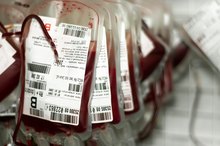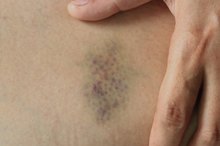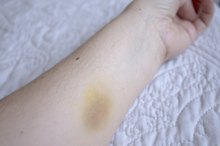Symptoms of Low Blood Platelet Count in the Elderly
Thrombocytopenia, the medical term for a low blood platelet count, occurs when blood platelets die faster than they’re reproduced. According to the Mayo Clinic, a healthy count ranges between 150,000 and 450,000 platelets for every microliter of circulating blood. A low platelet count occurs for several reasons. However, in the elderly it is most often as a result from arthritis, a malfunctioning immune system or chemotherapy. There are certain common symptoms that may be warning signs of thrombocytopenia in the elderly.
Excessive Bleeding
In simple terms, blood platelets are responsible for thickening blood. If a blood platelet count is reduced, the blood is more likely to hemorrhage which causes ruptured blood vessels, internal bleeding and excessive external bleeding. People with low blood platelet counts should apply immediate pressure to even minor cuts to stop the bleeding. They should also take extreme care when brushing and flossing teeth, as their gums will be more likely to bleed. Chemo Care recommends contacting a health care provider if a cut continuously bleeds for more than five minutes in spite of applying pressure 1.
- In simple terms, blood platelets are responsible for thickening blood.
- People with low blood platelet counts should apply immediate pressure to even minor cuts to stop the bleeding.
Internal Bleeding
Side Effects From a Blood Transfusion
Learn More
Internal bleeding is a serious symptom from thrombocytopenia. Even a simple injury can cause internal bleeding. A common sign of internal bleeding is the presence of blood in the urine. It may not occur until a day or more after the incident. If this occurs, contact a health care provider immediately. While rare, in extreme cases, people suffering from a low blood platelet count can have internal bleeding without a preceding injury, according to the Mayo Clinic.
- Internal bleeding is a serious symptom from thrombocytopenia.
- While rare, in extreme cases, people suffering from a low blood platelet count can have internal bleeding without a preceding injury, according to the Mayo Clinic.
Excessive Bruising
A bruise is the result of broken capillaries under the skin. Since a low blood platelet count causes thinning blood vessels, bruising is more likely to occur. It is typically an early sign of a low blood platelet count. If an elderly person begins to notice excessive bruising, he or a loved one should contact a health care provider. The provider can run tests to measure platelet count. According to Chemo Care, a doctor may suggest a prescription medication such as Oprelvekin or a platelet transfusion 1.
- A bruise is the result of broken capillaries under the skin.
- Since a low blood platelet count causes thinning blood vessels, bruising is more likely to occur.
Petechiae
How to Dry Out Wounds
Learn More
Blood platelets line the inside of the blood vessels. According to Chemo Care, if platelet count becomes low, the blood vessels can leak small amounts of blood 1. When this happens, tiny red dots form underneath the skin called petechiae. The dots resemble a common rash. This is one of the most common symptoms of thrombocytopenia. Elderly people who notice petechiae or other symptoms of thrombocytopenia should contact their health care provider and avoid certain over-the-counter medications that interfere with blood clotting such as aspirin or ibuprofen.
- Blood platelets line the inside of the blood vessels.
- According to Chemo Care, if platelet count becomes low, the blood vessels can leak small amounts of blood 1.
Related Articles
References
- Chemo Care
- Weycker, D., Hatfield, M., Grossman, A. et al. Risk and Consequences of Chemotherapy-Induced Thrombocytopenia in US Clinical Practice. BMC Cancer. 2019. 19(1).
- Zhang, X., Chuai Y., Nie, W., Wang, A., and G. Dai. Thrombopoietin Receptor Agonists for Prevention and Treatment of Chemotherapy-Induced Thrombocytopenia in Patients with Solid Tumours. Cochrane Database of Systematic Reviews. 2017. 11:CD012035.
- Estcourt, L., Stanworth, S., Doree, C., Hopewell, S., Trivella, M., and M. Murphy. Comparison of Different Platelet Count Thresholds to Guide Administration of Prophylactic Platelet Transfusion for Preventing Bleeding in People with Haematological Disorders after Myelosuppressive Chemotherapy or Stem Cell Transplantation. Cochrane Database of Systematic Reviews. 2015. 18(11):CD010983.
- Kuter, D. Managing Thrombocytopenia Associated with Cancer Chemotherapy. Oncology (Williston Park). 2015. 29(4):282-94.
Resources
Writer Bio
Maria Price worked as an editor for a medical publishing company for several years. She now does freelance editing and writing for various companies both in and out of the medical field. Price has a Master of Science degree from Drexel University in publications management.








